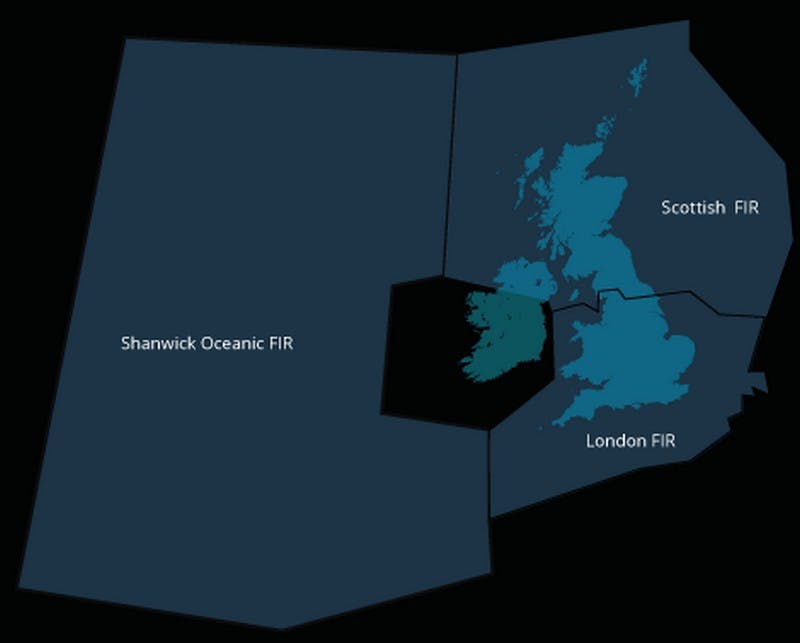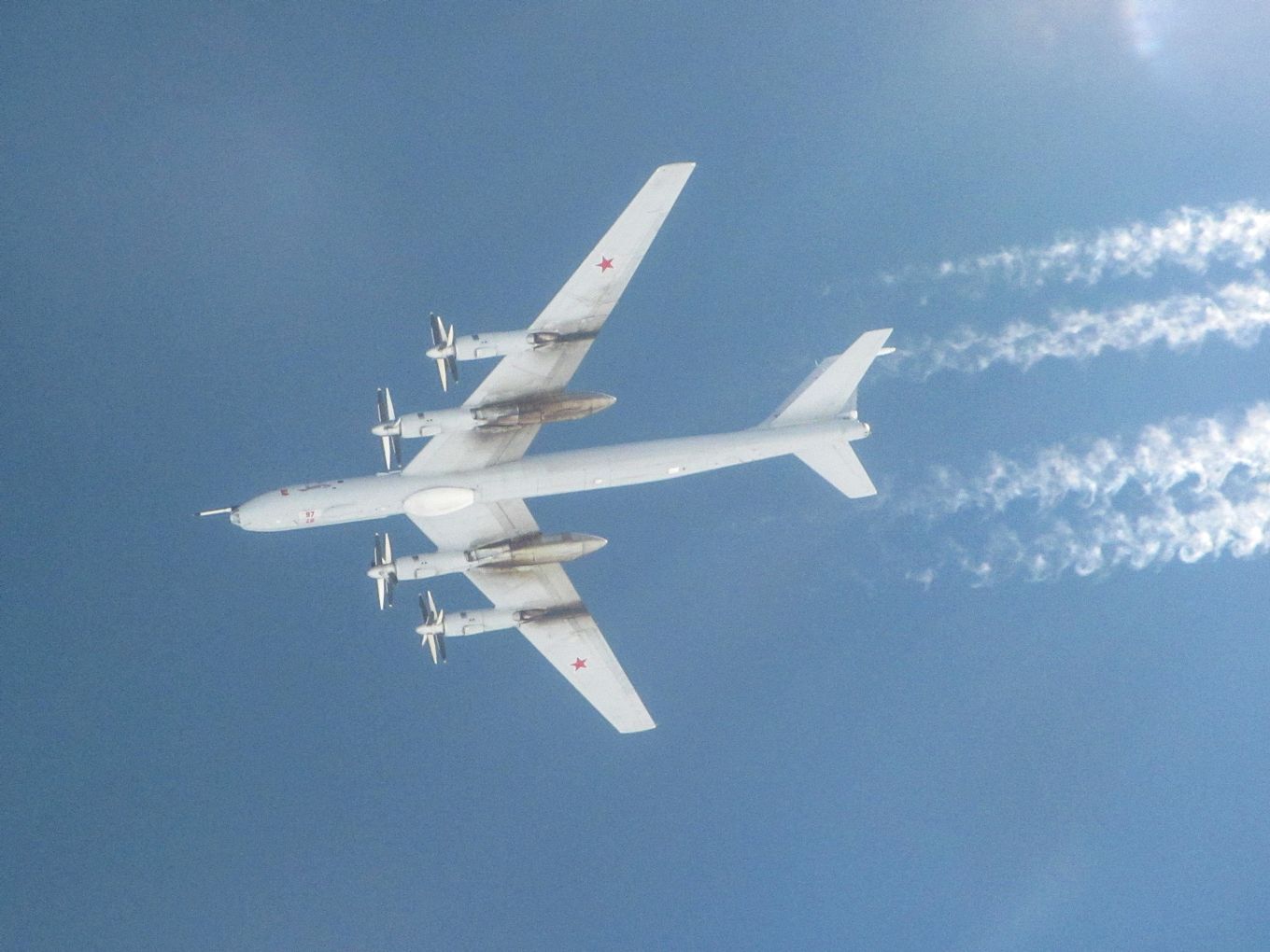Quick Reaction Alert Typhoons were scrambled from RAF Lossiemouth in the north of Scotland and were joined by a Voyager from RAF Brize Norton to provide air-to-air refuelling to the Typhoons, say the Royal Air Force.
The news release from the force said:
“A pair of TU-142 ‘Bear-F’ Maritime Reconnaissance and Anti-submarine warfare aircraft were tracked by NATO as they transited within NATO’s northern air policing area. As they continued to fly towards UK airspace, RAF Typhoons were launched. Intercepting the two cold war era aircraft over the North Sea, the RAF Typhoons shadowed the aircraft throughout their time in our area of interest.”
An unnamed Typhoon pilot from RAF Lossiemouth was quoted as saying:
“We worked closely with units from around the Royal Air Force to carry out this successful intercept, maintaining the integrity of UK and NATO airspace throughout. We were routed directly to the TU-142 by the RAF Control and Reporting Centre and kept informed by our NATO colleagues. Air-to-air refuelling from an RAF Voyager ensured we were able to stay on task until the mission was complete, and the aircraft departed from the UK’s area of interest.”
How does Quick Reaction Alert tasking work?
According to the RAF website, the National Air Defence Operations Centre (NADOC) at RAF Air Command, High Wycombe collates information from radar sites across the UK and from civilian air traffic and intelligence agencies.
“They decide the threat is sufficient to scramble Typhoon jets and pass the order to to the Control and Reporting Centres (CRCs) at RAF Scampton and RAF Boulmer. The CRCs have direct contact with the pilots at RAF Lossiemouth and pass on the scramble message. Pilots at RAF Coningsby are ordered to standby in the cockpits of their Typhoons. RAF Coningsby is the second QRA station in the UK.”
Essentially, the jets and their crews are at a moments notice to launch and intercept unresponsive or dangerous aircraft.
Why does the UK intercept aircraft outside of its own airspace?
Andy Netherwood, a former Royal Air Force pilot, explained why this is done.
“A country’s sovereign airspace extends 12 miles beyond its coastline, sitting above its territorial waters. However, there are 3 main reasons why unknown or potentially hostile aircraft must be intercepted before they reach this point.”

“The first is flight safety. Whilst sovereign airspace only extends 12 miles from the coastline, countries are responsible for ensuring the safety of civil aviation, including the provision of ATC services, within areas known as Flight Information Regions or FIRs. These extend well beyond the 12-mile limit. Russian long range aviation often transits the London and Scottish FIRs without filing a flight plan, talking to ATC or ‘squawking’ (operating their transponders). This makes them effectively invisible to civilian ATC and is very dangerous as airliners are also flying through this airspace. By shadowing Russian aircraft, the intercepting aircraft can show ATC where they are, allowing controllers to move airliners safely out of the way.
The second reason is because of the speed at which aircraft travel. An aircraft flying at 600 knots will travel 12 miles in little over a minute. Waiting until an unknown or hostile aircraft has entered sovereign airspace before intercepting is too late. It leaves insufficient time to safely carry out the intercept, visually identify the aircraft, provide all the required information back to decision-makers, and carry out any necessary action. Russian aircraft will normally be intercepted by the Norwegian Air Force and then handed over to RAF aircraft ensuring they are continually shadowed.”

“The final reason is to demonstrate capability and intent. One of the reasons Russia carries out these exercises is to test NATO and the UK. A failure to intercept would be interpreted as weakness and encourage further probing.”
For more on why the RAF intercept aircraft around the UK, you can read the full piece.
This happens often, doesn’t it?
No doubt you’ve probably noticed dozens of comments on our Facebook page saying something like, ‘nothing new’ or ‘This happens all the time it is not news!’.
While this is a common occurrence, we believe that its important for the public to know that. After all, if it isn’t reported frequently, how are people to know it’s a frequent occurrence and not something to worry about?














https://www.instagram.com/p/CSPR_POqQ4y/?utm_medium=copy_link
Nice demo of the Typhoon wide area display for those who are interested 👍
Thanks for that Robert, looks really cool. Typhoon is being nicley kept up to date with the incremental develop programme. Definately, the way to run complex programmes.
Cheers CR
Awesome Robert – thank you for sharing. Will all of our Typhoons be getting this upgrade?
I have no idea. Definitely the aircraft that will receive the new radar Mk2. Currently the tranche 3 aircraft, but hopefully tranche 2 too.
Thanks Robert. Very interesting. Essential to keep Typhoon at the cutting edge of technology.
“if it isn’t reported frequently, how are people to know it’s a frequent occurrence”
Couldn’t agree more. The people of this country need to understand the growing threat we face and the only way they will become aware is if they are repeartedly told… Sadly.
Keep up the good work.
Cheers CR
Isn’t it true that NATO aligned countries also test Russian, Chinese and other countries defences also though ?
That is the great gift of George, and his team, to collate all the disparate press releases etc and put them in one place so everyone can see the volume of what the forces are doing on a daily basis.
I do think site like UKDJ and SRN/NL have had an effect in changing political conciouness. Sure there was a groundswell of reasonably well plugged in senior politicos that were making a lot of noise about the cumulative inadequacies. Also Boris’ Churchillian bluster made a modest rearmament seem the natural thing – Boris could not really be seen to cut defence!
Your a bit optimistic about that. When Boris insisted on big muti year increase the only happy people in Govt were at MoD.
They were easily spotted once in visual range due to, firstly, the black smoke pumping out of their engines and secondly, the airborne tug towing them across the sky……..😁
I believe the T142 Bear is the world’s loudest aircraft with it’s turboprops continuous sonic booms from the speed of the blades rotation. Our submarines can hear them coming long before the Bear’s can deploy sonar buoys.
Whilst true that SSNs can detect and track Tub142 Bears at considerable range, the same is true of any turbo prop aircraft including helicopters. The propellors/rotors working just like a ships prop, just in air.
The greater speed (rotational rate) of an aircrafts prop just shows up higher in the frequency spectrum on analysis equipment. As the vast majority of aircraft/ helicopters use different engines rotating at different speeds, they can be fingerprinted to a specific type, eg Bear, P-3, Merlin etc.
It’s not a sonic boom that’s detected from turbo prop aircraft, it’s the persistent rotation of the engines (droning) that is detected by Submarines.
Thanks for that Deep32. I still think that the Bear is the loudest military aircraft though…
It is certainly the loudest turbo prop by some margin!!!
During cold war there were reports that NATO pilots intercepting suffered from temp hearing loss, headaches etc. It makes you wonder about the poor so and so’s who had to fly the damn things.
Some of their missions lasted 12-14 hours, I imagine that their H&S policy was a bit lacking!!!!!
Certainly a pair of good quality noise cancelling headphones might be the order of the day!! But yes. I wouldn’t fancy it.
😁 😁
Sounds like Ajax!!!
😃 😃
Probably to do with the counter roatating props
Anyone know the if the QRA use 2 or 3 drop tanks? I always see 2 in the pictures and The centreline is not used.
I think the missile load out is the 4 meteor/amraam on the semi recessed pylons with 2-4 asraams on the out pylons.
Generally only the two drop tanks. They get topped up by a Voyager anyway.
So basically every Nato fighter from 1955 on could have easily intercepted the aircraft.. except for the really short-legged ones.
It depends on where in the North Sea and whether there was tanker support available?
If it was a English Electric Lightning even with drop tanks fitted, it wouldn’t be able to stay with the Bear, like the later Phantom, Tornado F3 or Typhoon could do. It had to have tanker support, otherwise it would be a quick interception to confirm what the aircraft was and then a return to base. It was the same with the Starfighter, The Mirage III had the legs for about an hours worth when on station, before needing tanker support.
V=What would the RAF be tasked to do if the Soviet aircraft crossed over into British airspace ?.
Intercept.
Fire flares as warning to get to divert.
Fire cannon as warning ( if they have one )
If still doesn’t respond or continues on course towards civilian areas, military targets, shoot down.
A Mig 23 Flogger did that once. NATO left it be as it was pilotless and it went down in Belgium.
Hopefully the Russians would not be that provocative…..unlike the western recc aircraft who would enter Russian airspace with impunity!
Shoot the bu**ers down and blame the Scottish Airforce.
The Russians were probably having a goodwill visit with wee Sturgeon and her rebel pals.
lol ye or even offering her a RT talk show slot.
Russia sends one 50 year old Bear everyday at a cost of £5,000 / hour. The UK responds with 2 Typhoons and a Voyager at a cost if £50,000 / hour.
Who get the rough end of the deal?
( Not to mention the wear and tear on theTyphoon airframes. )